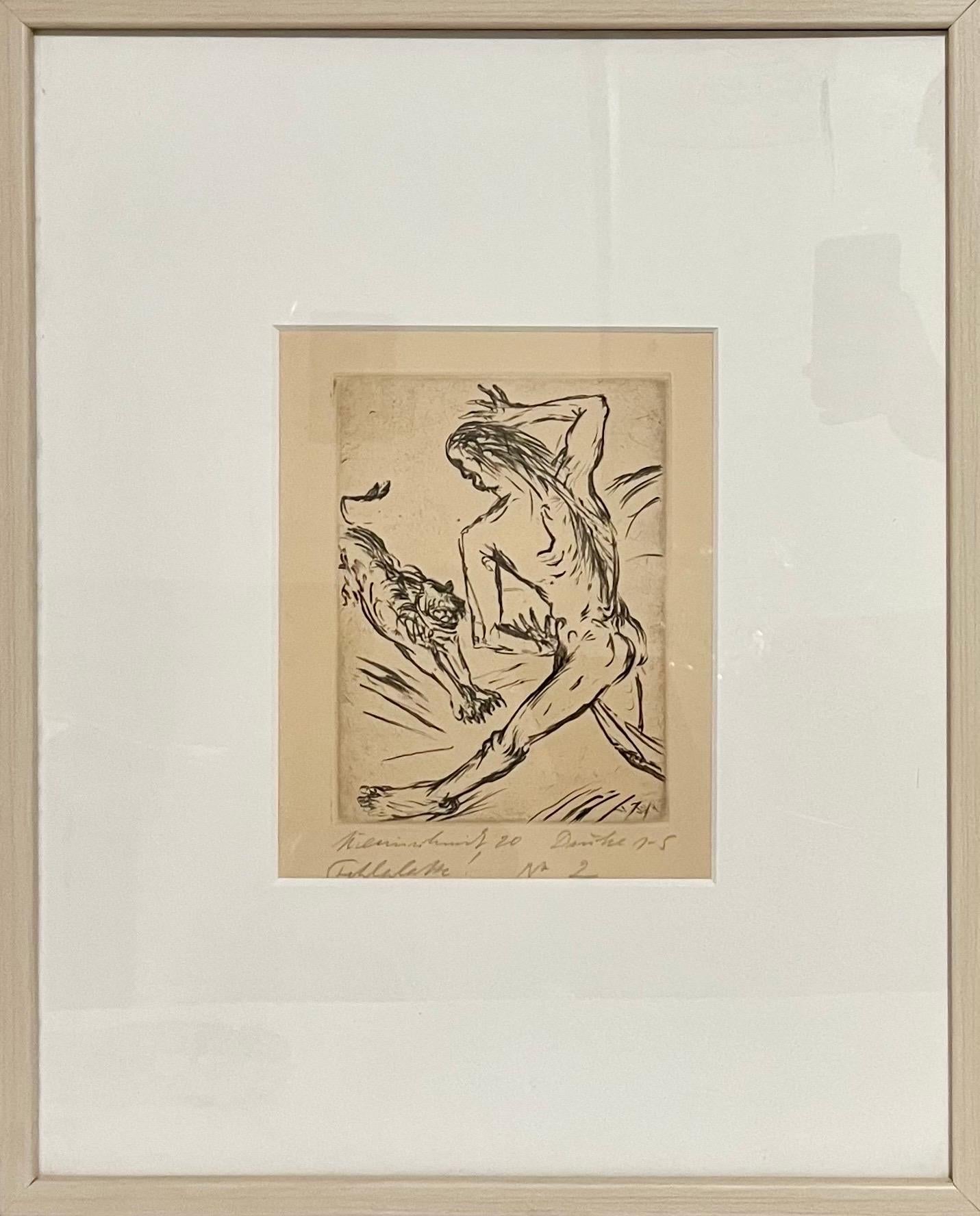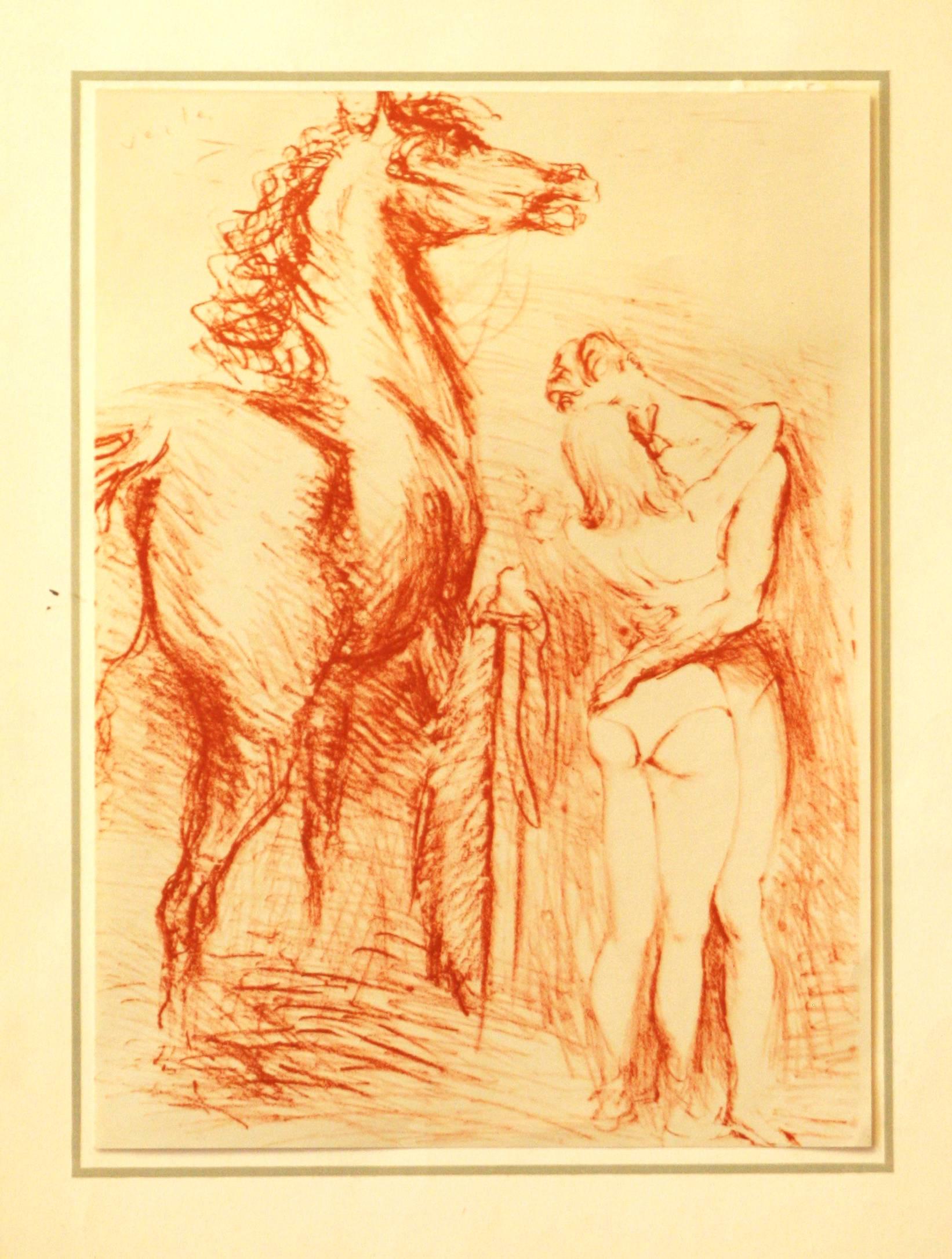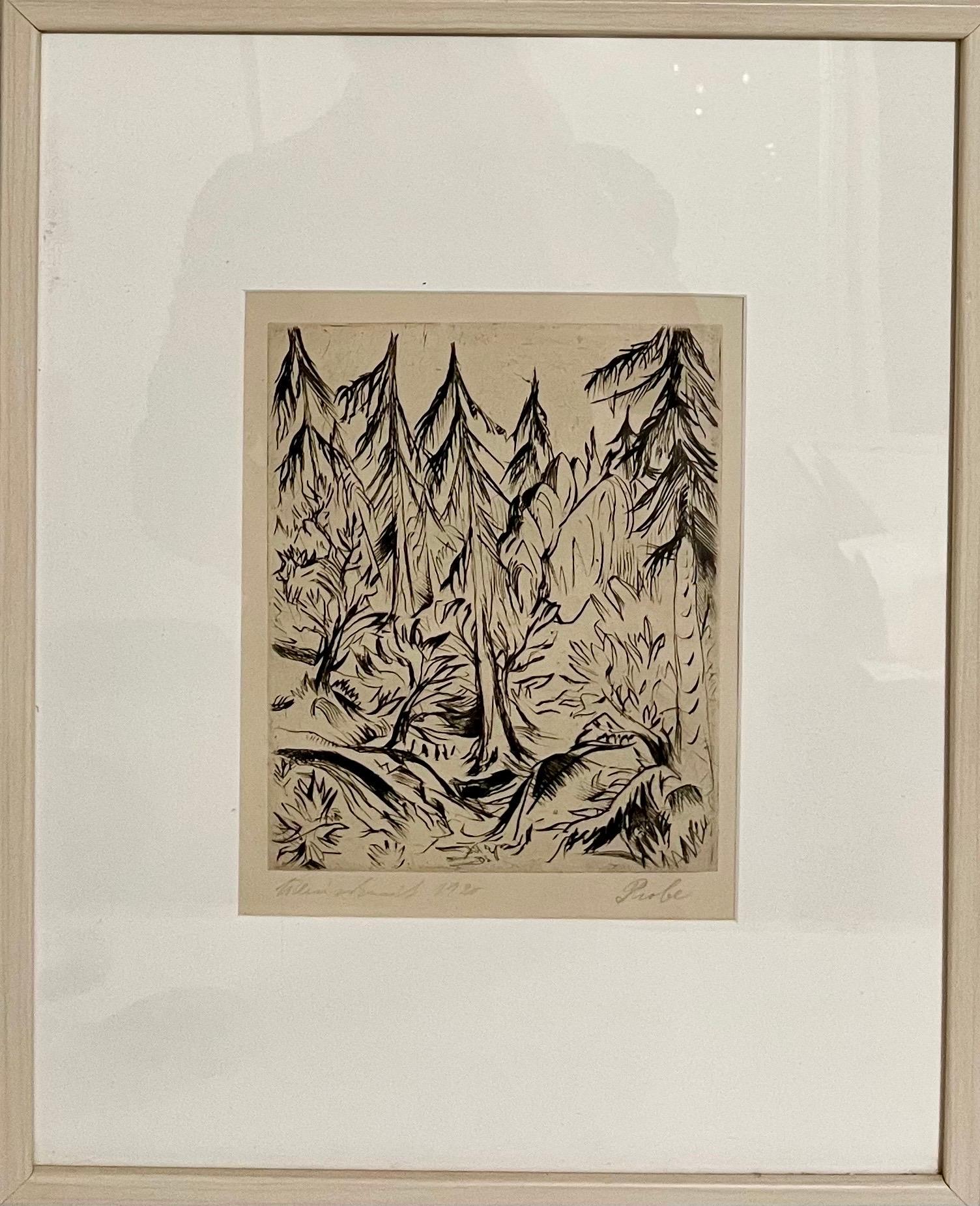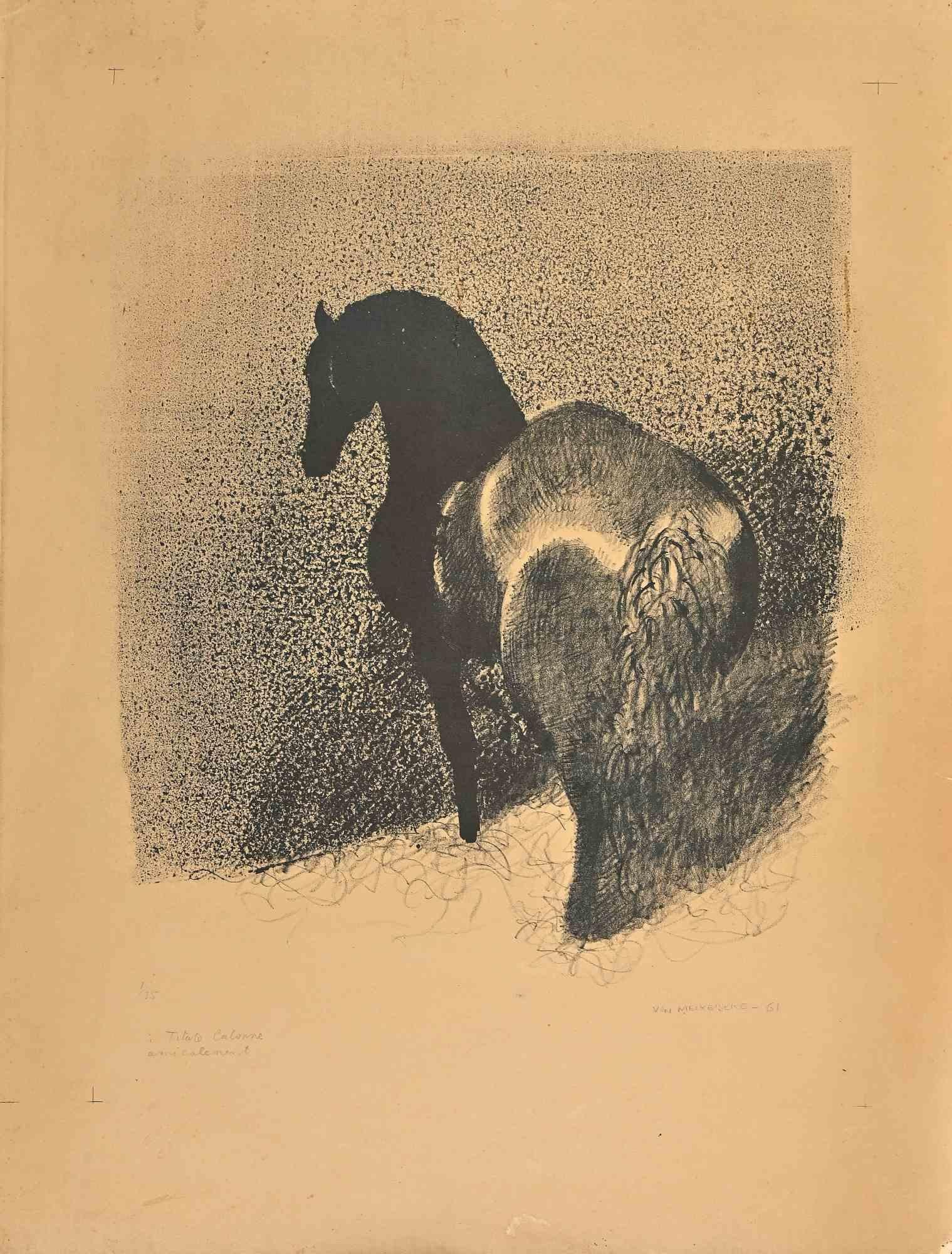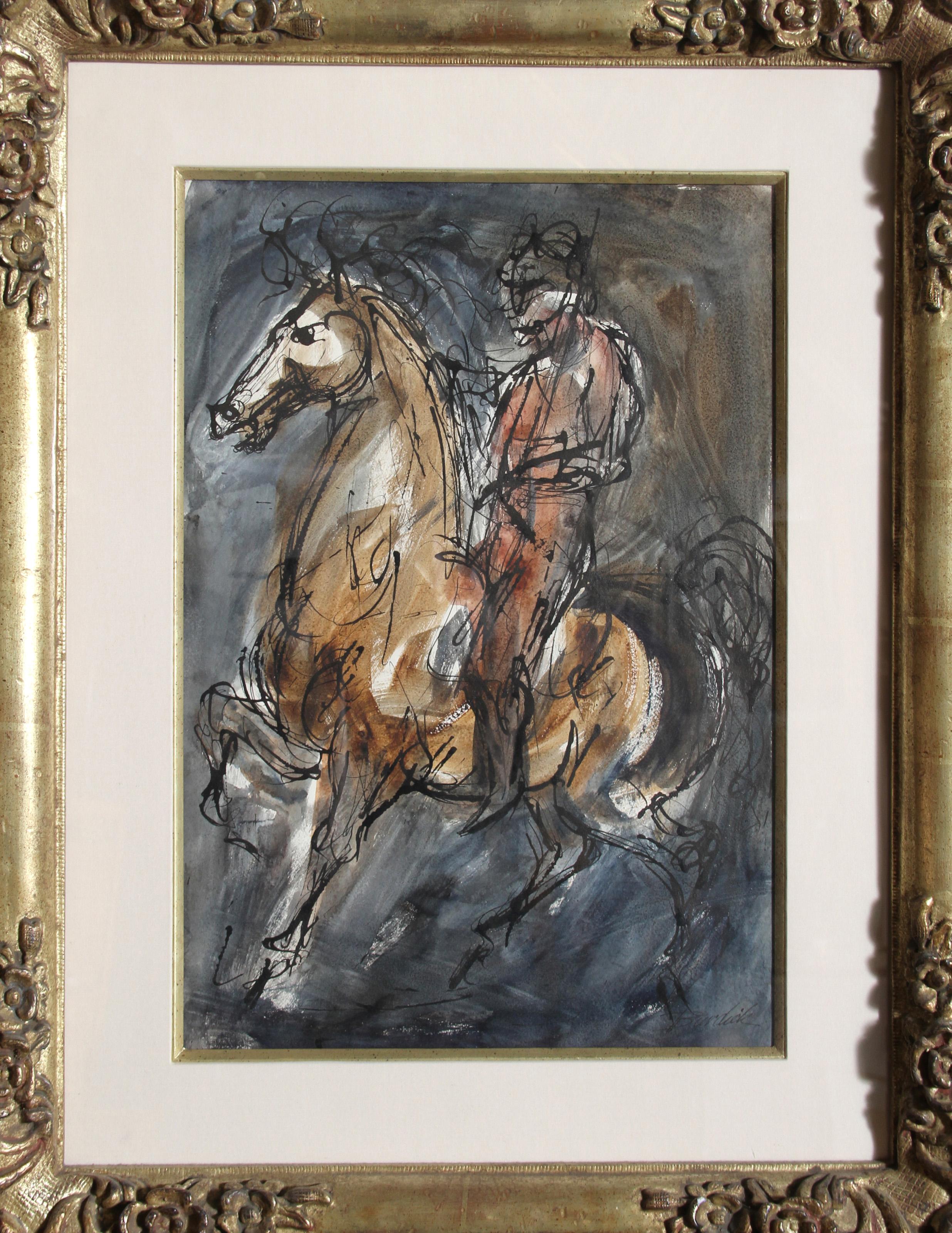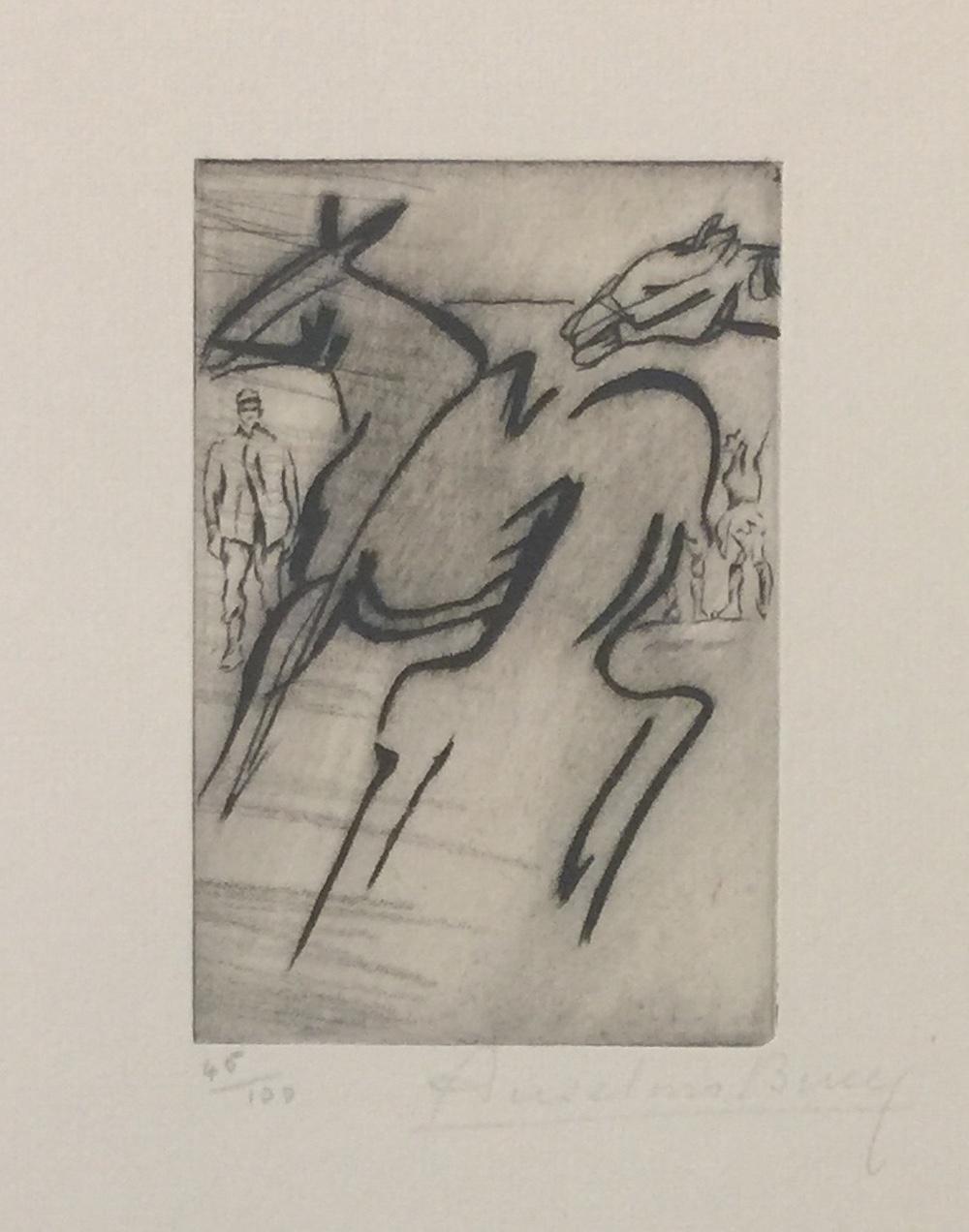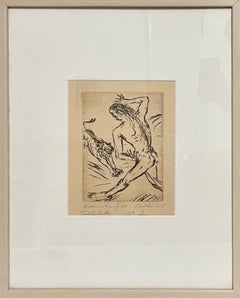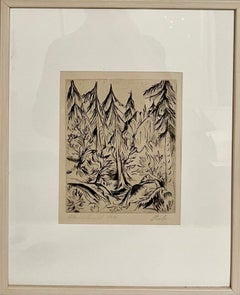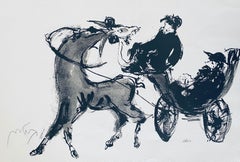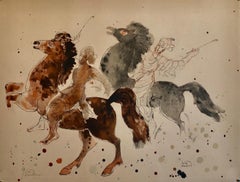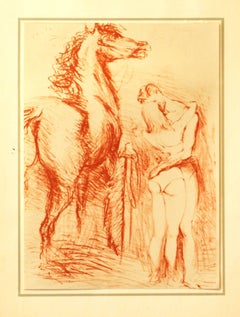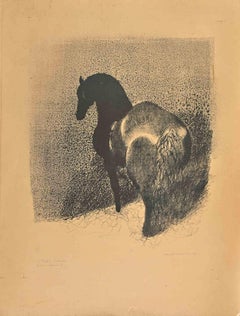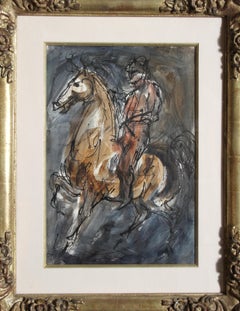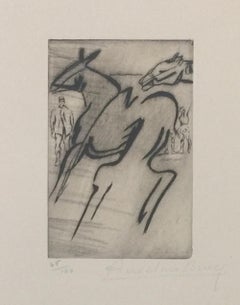Items Similar to 1916 German Expressionism Figurative Lithograph Man Two Horses Paul Kleinschmidt
Want more images or videos?
Request additional images or videos from the seller
1 of 10
Paul Kleinschmidt1916 German Expressionism Figurative Lithograph Man Two Horses Paul Kleinschmidt1916
1916
$1,600
£1,220.76
€1,389.74
CA$2,248.82
A$2,472
CHF 1,297.79
MX$29,393.84
NOK 16,666.54
SEK 15,181.42
DKK 10,383.58
About the Item
Paul Kleinschmidt, (1883–1949)
"Man & Two Horses" Lithograph
1916
Frame: 21" X 17"
Image: 13.5" X 10.5"
Rare Artist's Proof
Provenance: bears labels from ACA Galleries and Richard A. Cohn LTD.
Paul Kleinschmidt, (1883–1949) was a Polish born German Expressionist painter. Known for both Impressionism and Expressionism.
Kleinschmidt was born in Bublitz, Pomerania, German Empire (modern Bobolice, Poland). As a student of art at the Berlin Akademie Kleinschmidt's greatest influence was Anton von Werner, who was at the time Kleinschmidt's history art teacher.
During his time as a student Kleinschmidt met Lovis Corinth who became an informative and strongly educational individual for the young student. Kleinschmidt continued his studies in 1904 under Peter Halm's direction, as well as Heinrich von Zügel at the Akademie in Munich. It was in Munich that he learned the techniques of lithography and engraving.
Eventually finding his way to Berlin to work as a painter and graphic artist, Kleinschmidt exhibited at the 'Sezession' shows in 1908 and 1911.
Many important artists were active or joined, Max Beckmann, Ernst Barlach, Wassily Kandinsky, Kathe Kollwitz, Emil Orlík, Lyonel Feininger, Hans Meid, Edvard Munch, Max Pechstein, Max Liebermann, Emil Nolde were all Berlin Secessionists. In 1915, Kleinschmidt began teaching drawing while also taking the role of a technical draughtsman, during which time a great majority of his most remarkable lithographs and engravings were created. Offering these pieces in his first solo exhibition, organized by the Euphorion publishing company in 1923, Kleinschmidt's work would next see light in 1925 at Fritz Gurlitt in Berlin, thereafter graduating to a painting oriented focus. Kleinschmidt was first introduced to a New York City art collector by the name of Erich Cohn in 1927. A man who later became his sponsor. Kleinschmidt made several rapid moves from Berlin throughout Southern Germany in 1932 ending up in Ulm and within a year's time, Ay near Senden. Shortly thereafter, he and his family found a great struggle in the midst of a political repression. Finally finding a path of emigration to the Netherlands in 1936, Kleinschmidt relieved himself and family of such political angst, from there to France in 1938.
Kleinschmidt's pictorial world is mostly dominated by dazzling, exuberant and sensual women, whom he portrayed as modern monuments of femininity. Oil painting Inspired by the Berlin nightlife of the 1920s as well as by his childhood spent in a traveling circus, he uses expressive painting techniques to locate barmaids, waitresses, prostitutes, dancers and circus riders draped with erotic accessories or cake buffets in the milieu around bars, cafés and variety shows. The National Socialists took offence at such depictions and ostracized Kleinschmidt's art. They confiscated some of the works and showed some of them at the Munich exhibition Entartete Kunst, "Degenerate Art" in 1937 along with the best of German Expressionism. In addition, he was banned from painting, but this could not dissuade him from continuing his work. He was taken prisoner in February 1940 throughout several camps for a short span but released again post-French capitulation. George Grosz has written of Kleinschmidt as one of the great German Expressionist artists. "Kleinschmidt occupies a special position in German art and is a master in his own right. His place is between Lovis Corinth and the Expressionists." Kleinschmidt was forced to stop painting in 1943 under direction of the Nazis during his final years in Bensheim. In 1945, the entirety of his possessions were lost to an air raid. Kleinschmidt died on August 2, 1949, as result of a severe angina pectoris diagnosed in 1940.
Paul Kleinschmidt has been in four exhibitions at MoMA, NYC
German Painting and Sculpture April 1931 with Paul Klee, George Grosz, Ernst Ludwig Kirchner and Max Beckmann and others.
Summer Exhibition: Painting and Sculpture, October 1932
with Pablo Picasso, Henri Matisse, Paul Klee and Fernand Léger etc.
Recent Acquisitions, 1968–1973 September 1973
with Henri Matisse, Joan Miró, Georges Braque and Jasper Johns etc.
The Expressionist Idiom, December 1985 withPablo Picasso, Henri Matisse, Paul Klee and Georges Rouault, among others, were invol
- Creator:Paul Kleinschmidt (1883 - 1949, German)
- Creation Year:1916
- Dimensions:Height: 21 in (53.34 cm)Width: 17 in (43.18 cm)
- Medium:
- Movement & Style:
- Period:
- Condition:Please refer to photos.
- Gallery Location:Surfside, FL
- Reference Number:1stDibs: LU38215043272
About the Seller
4.9
Platinum Seller
Premium sellers with a 4.7+ rating and 24-hour response times
Established in 1995
1stDibs seller since 2014
1,846 sales on 1stDibs
Typical response time: <1 hour
- ShippingRetrieving quote...Shipping from: Surfside, FL
- Return Policy
More From This Seller
View All1920 German Expressionist Figurative Etching Daniel with Lion Paul Kleinschmidt
By Paul Kleinschmidt
Located in Surfside, FL
Paul Kleinschmidt, (1883–1949)
"Daniel" Etching
1920
Frame: 21" X 17"
Image: 9.5" X 7.5"
Daniel in the Lions Den
Rare Artist's second proof
Provenance: bears labels from ACA Gallerie...
Category
1920s Abstract Figurative Prints
Materials
Etching
1920 German Expressionist Figurative Lithograph "The Forest" Paul Kleinschmidt
By Paul Kleinschmidt
Located in Surfside, FL
Paul Kleinschmidt, (1883–1949)
"The Forest"
Lithograph on Cream Paper
1920
Frame: 21" X 17"
Image: 10.75" X 8.5"
An expressionist forest scene with pine trees
Provenance: bears label...
Category
1920s Abstract Figurative Prints
Materials
Lithograph, Paper
Polish Israeli Artist Expressionist Hand Signed Lithograph
By Moshe Bernstein
Located in Surfside, FL
Born in Poland in 1920, Bernstein completed his art studies in the Academy of Vilna in 1939. His family was wiped out in the Holocaust, but he survived the war and lived in Russia un...
Category
Mid-20th Century Expressionist Prints and Multiples
Materials
Lithograph
Modern Israeli Lithograph Reuven Rubin Views Of Israel Judaica Horses, Riders
By Reuven Rubin
Located in Surfside, FL
Lithograph printed by Chez Daniel Jacomet, Paris, France 1960 offset lithograph in colors on Arches, signed in crayon on the justification sheet (this auction is just for the one lithograph pictured as the 1st photo, the justification sheet with the original drawing is just included for provenance and is not part of this sale), on Arches deckle edged paper. limited edition of 250. plate signed and hand signed in pencil.
Israeli views Lithograph by Israeli Master.
Reuven Rubin 1893 -1974 was a Romanian-born Israeli painter and Israel's first ambassador to Romania.
Rubin Zelicovici (later Reuven Rubin) was born in Gala?i to a poor Romanian Jewish Hasidic family. He was the eighth of 13 children. In 1912, he left for Ottoman-ruled Palestine to study art at Bezalel Academy of Art and Design in Jerusalem. Finding himself at odds with the artistic views of the Academy's teachers, he left for Paris, France, in 1913 to pursue his studies at the École Nationale Supérieure des Beaux-Arts. At the outbreak of World War I, he was returned to Romania, where he spent the war years.
In 1921, he traveled to the United States with his friend and fellow artist, Arthur Kolnik, with whom he had shared a studio in Cernovitzu. In New York City, the two met artist Alfred Stieglitz, who was instrumental in organizing their first American show at the Anderson Gallery.Following the exhibition, in 1922, they both returned to Europe. In 1923, Rubin emigrated to Mandate Palestine.
Rubin met his wife, Esther, in 1928, aboard a passenger ship to Palestine on his return from a show in New York. She was a Bronx girl who had won a trip to Palestine in a Young Judea competition. He died in 1974
Artistic career
Joseph Zaritsky...
Category
1960s Modern Figurative Prints
Materials
Lithograph, Offset
Horseman & Indian, American Modernist Abstract Etching
By Robert A. Birmelin
Located in Surfside, FL
Born in Newark, New Jersey, Robert Birmelin became a professor of fine arts at Queens College in New York, and is known for paintings that magnify through texture the realism of natu...
Category
20th Century American Modern Interior Prints
Materials
Etching
Horseman & Indian, American Modernist Abstract Etching
By Robert A. Birmelin
Located in Surfside, FL
Born in Newark, New Jersey, Robert Birmelin became a professor of fine arts at Queens College in New York, and is known for paintings that magnify through texture the realism of natu...
Category
20th Century American Modern Interior Prints
Materials
Etching
You May Also Like
Equestrian Love lithograph by Marcel Vertes
By Marcel Vertès
Located in Paonia, CO
Equestrian Love is from Vertes's circus series. Two lovers are embracing in a passionate kiss a few feet away from a majestic stallion drawn in sepia on yellowish paper. Original Lithograph in good condition, backed on original paper and signed in plate.
Marcel Vertes...
Category
Mid-20th Century Expressionist Figurative Prints
Materials
Lithograph
Horse - Lithograph by Jacques Van Melkebeke - 1961
Located in Roma, IT
Horse is a lithograph realize by Jacques Van Melkebeke in 1961.
Good conditions.
Numbered.Edition 1/25
The artwork is represented through soft strokes.
Category
1960s Modern Figurative Prints
Materials
Lithograph
Horseman, Modern Ink and Acrylic Painting on Paper by Charles Burdick
By Charles Burdick
Located in Long Island City, NY
Charles Burdick, American (1924 - ) - Horseman, Year: circa 1970, Medium: Ink and Acrylic on Paper, signed, Size: 20 x 14 in. (50.8 x 35.56 cm), Frame Size: 28 x 22 inches
Category
1970s Modern Animal Drawings and Watercolors
Materials
Ink, Acrylic
Le Coup de Canon - Original Etching by Anselmo Bucci - 1917
By Anselmo Bucci
Located in Roma, IT
Image dimensions: 13 x 8.5 cm.
Hand signed. Edition of 100 prints on Hollande paper. From the collection: “Croquis du Front Italien” , published in Paris by D'Alignan editions. Anse...
Category
1910s Futurist Figurative Prints
Materials
Drypoint, Etching
Abstract Style Equestrian Lithograph by Camille Hilaire
Located in West Palm Beach, FL
Wonderful equestrian lithograph done in a very contemporary abstract way. Coloration pops.
Category
20th Century French Contemporary Art
Materials
Paper
Reginald Wilson, Horses
By Reginald Wilson
Located in New York, NY
Although this work is titled Horses. It nice to think it could be (Horses in a Field in Woodstock, NY), but it was printed by Will Barnet at the Art Students League, about 1938, and Wilson, who visited Woodstock with Arnold Blanche...
Category
1930s American Modern Animal Prints
Materials
Lithograph
More Ways To Browse
Antique Work Light
Antique German Horse
Durer Original
Dylan Glaser
Etching On Silk Print
Fake Street Art
Flog Art
Frank Sinatra Hirschfeld
Grosz Interregnum
Hand Signed Norman Rockwell
Hector Julio Paride Bernabo
Henri Matisse Nadia
Henry Monnier
Henry Moore Sculptural Objects
Hirschfeld Nina
Hockney Parade
Hokusai Woodblock Prints
Horse Woman Picasso
